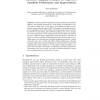Free Online Productivity Tools
i2Speak
i2Symbol
i2OCR
iTex2Img
iWeb2Print
iWeb2Shot
i2Type
iPdf2Split
iPdf2Merge
i2Bopomofo
i2Arabic
i2Style
i2Image
i2PDF
iLatex2Rtf
Sci2ools
CMMR
2008
Springer
2008
Springer
Dynamic Mapping Strategies for Expressive Synthesis Performance and Improvisation
Realtime musical expression through synthesis is notoriously dicult. The complete potential of a sound engine is traditionally available only at design time. In this paper two mapping strategies are presented, adressing this problem. Based on dynamic and random many-tomany mappings between control space and synthesis space, they erase the line between sound editing and synthesizer performance, with an emphasis on free improvisation. One strategy is based on the addition of random vectors in synthesis space, weighted by control parameters. The other is based on a gravity analogy, interpolating between random points in synthesis space, with the gravities controlled by player interaction. Vectors and point sets can be scaled and shifted during performance, allowing dynamic exploration of vast soundspaces or minute timberal control. The mappings have been adopted to a wide range of musical interfaces. Together with suitable sound engines, surprisingly expressive performance instruments hav...
| Added | 18 Oct 2010 |
| Updated | 18 Oct 2010 |
| Type | Conference |
| Year | 2008 |
| Where | CMMR |
| Authors | Palle Dahlstedt |
Comments (0)

